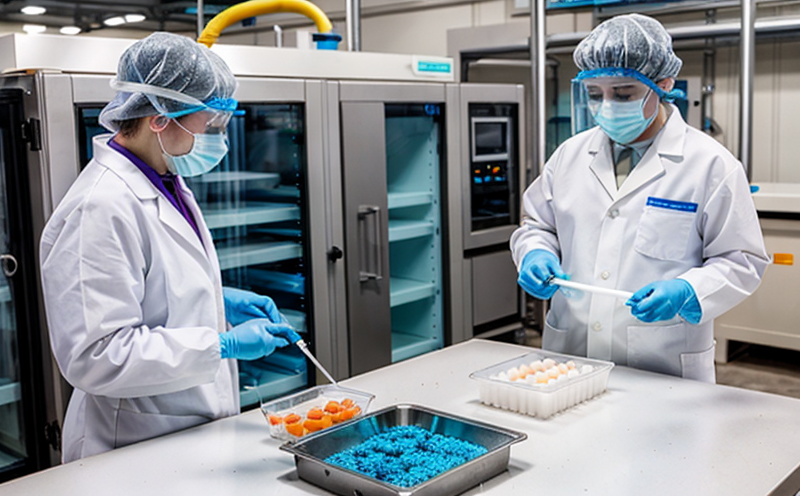ISO 22196 Antibacterial Activity Testing on Toy Surfaces
The ISO 22196:2011 standard for antibacterial activity testing is a crucial guideline in ensuring the safety and well-being of children who frequently come into contact with toys. This test evaluates whether surfaces are effective at inhibiting bacterial growth, which helps prevent potential infections and illnesses. Compliance with this standard ensures that toy manufacturers adhere to stringent international health and safety standards.
The testing process is meticulous: it involves inoculating the toy's surface with a known strain of bacteria, allowing time for bacterial growth, and then applying an antibacterial agent or treatment designed to inhibit microbial activity. The effectiveness is measured by comparing the initial bacterial load before application to the residual count after exposure to the antimicrobial substance.
For quality managers and compliance officers, this service ensures that their products meet global safety standards and are free from harmful microorganisms. R&D engineers benefit from this testing as it aids in developing new materials or surface treatments that can enhance microbial resistance without compromising toy functionality. Procurement teams also find value in this service since they can verify the quality of components before integrating them into final products.
The ISO 22196 standard is not just about compliance—it's an investment in your product's reputation and consumer trust. In today’s world, parents are increasingly concerned with the safety of toys for their children. By ensuring that your products pass this rigorous test, you demonstrate a commitment to safety and quality.
Compliance with ISO 22196 is essential as it aligns with international regulatory requirements. This standard ensures that toys do not harbor harmful bacteria, thus promoting better health outcomes among users. The testing process itself is designed to mimic real-world conditions, providing accurate results that can be relied upon for informed decision-making.
| Test Parameter | Description |
|---|---|
| Bacterial Strain | Standardized bacterial strains used in testing to ensure consistent results. |
| Treatment Exposure Time | The duration for which the antibacterial agent is applied and allowed to work before measurement. |
| Inoculation Volume | The amount of bacteria introduced onto the toy surface prior to treatment application. |
| Sampling Methodology | Specific techniques used for collecting samples from treated surfaces post-treatment. |
This table outlines key parameters that are crucial in performing ISO 22196 testing. Each parameter plays a vital role in ensuring the accuracy and reliability of the results, thereby supporting informed decision-making processes within toy manufacturing companies.
Why It Matters
The importance of microbiological safety cannot be overstated, especially when it comes to products that children frequently handle. Toys are often in direct contact with skin and can easily pick up and spread bacteria. Ensuring toys meet stringent standards like ISO 22196 is not only a legal requirement but also a moral responsibility towards child health.
By conducting thorough antibacterial activity tests, manufacturers can identify potential risks early on and implement necessary changes to enhance product safety. This proactive approach helps protect children from preventable illnesses and infections, fostering healthier environments for playtime activities.
The global reach of ISO 22196 ensures that toy manufacturers adhere to the same stringent standards worldwide, promoting consistency in quality across various markets. Compliance with this international standard builds trust among consumers who value safety above all else when it comes to their children's health and well-being.
Environmental and Sustainability Contributions
- Reduction of Antibacterial Agents Use: By ensuring toys are inherently resistant to bacterial growth, the need for frequent application of antibacterial agents is minimized. This leads to reduced chemical exposure in both manufacturing environments and households.
- Sustainable Manufacturing Practices: Adhering to ISO 22196 encourages sustainable practices by promoting longevity and durability of toys, reducing waste generation and resource consumption over time.
- Eco-Friendly Materials: Manufacturers are incentivized towards using eco-friendly materials that not only enhance microbial resistance but also contribute positively to environmental sustainability.
The focus on minimizing the use of harmful chemicals and promoting sustainable practices aligns with broader goals of reducing environmental impact while enhancing product safety. By integrating these principles into toy manufacturing processes, companies can significantly contribute to a more responsible approach towards production methods.
Use Cases and Application Examples
| Case Study | Description |
|---|---|
| New Toy Design: | A manufacturer launches a new line of interactive toys designed for infants. To ensure they are safe, the company opts for ISO 22196 testing to verify that all toy surfaces inhibit bacterial growth effectively. |
| Material Innovation: | Innovative materials are introduced into a popular children's toy range. Testing with ISO 22196 ensures these new materials do not compromise the antibacterial properties of existing products. |
| Product Recall: | A batch of toys is recalled due to suspected bacterial contamination. Testing with this standard helps identify any potential issues and confirms whether the recall was necessary or if it can be safely reintroduced into circulation. |
In each case, ISO 22196 testing provides critical insights that help manufacturers make informed decisions regarding product safety and compliance. These examples illustrate how this testing standard is widely applicable across various stages of toy development and quality assurance.





